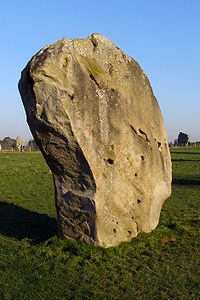
Barber surgeon of Avebury
Encyclopedia

England
England is a country that is part of the United Kingdom. It shares land borders with Scotland to the north and Wales to the west; the Irish Sea is to the north west, the Celtic Sea to the south west, with the North Sea to the east and the English Channel to the south separating it from continental...
county of Wiltshire
Wiltshire
Wiltshire is a ceremonial county in South West England. It is landlocked and borders the counties of Dorset, Somerset, Hampshire, Gloucestershire, Oxfordshire and Berkshire. It contains the unitary authority of Swindon and covers...
will have heard.
The traditional story goes as follows:
A pious traveller was assisting the folk of Avebury in burying the pagan standing stones in the village during the fourteenth century. Alas as he was busily digging out the underside of a stone it fell over, crushing him and entombing him beneath it. The archaeologist Alexander Keiller
Alexander Keiller
Alexander Keiller was an archaeologist and businessman who worked on the site at Avebury in Wiltshire. He used his wealth to acquire a total of of land for preservation, conducted excavations, re-erected stones on the site, and created a museum to interpret the site. He founded the Morven...
lifted the stone to reinstate it in 1938 and found the man's remains underneath. Items found with the body including coins, scissors and an iron medical probe identified him as an itinerant mediaeval barber surgeon
Barber surgeon
The barber surgeon was one of the most common medical practitioners of medieval Europe - generally charged with looking after soldiers during or after a battle...
who had sadly been hoisted by his own petard
Petard
A petard was a small bomb used to blow up gates and walls when breaching fortifications. The term has a French origin and dates back to the sixteenth century...
.
Keiller sent the remains to the curator of the museum at the Royal College of Surgeons
Royal College of Surgeons of England
The Royal College of Surgeons of England is an independent professional body and registered charity committed to promoting and advancing the highest standards of surgical care for patients, regulating surgery, including dentistry, in England and Wales...
, whom he felt would appreciate the find. It was thought to have been destroyed during bombing in the Second World War but was rediscovered and re-examined in 1998. A large healed cut wound was noticed on the skull but no evidence of traumatic death was identified and it was suggested that the man had been buried beneath a stone rather than crushed by it.

